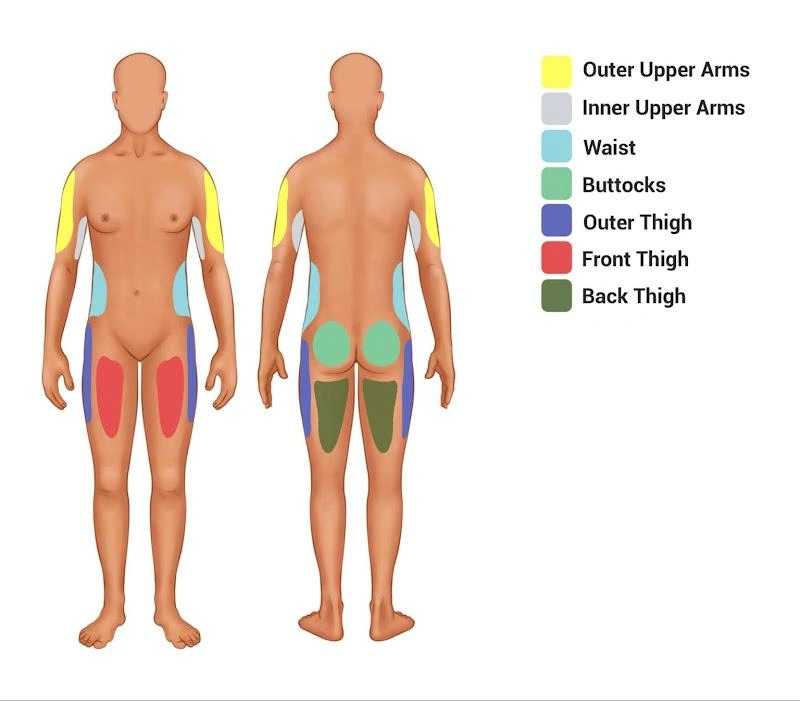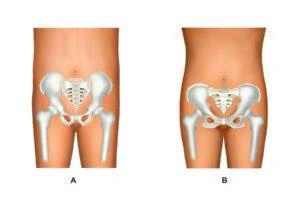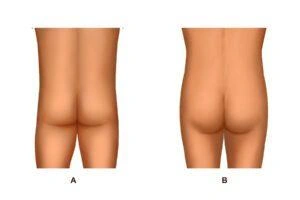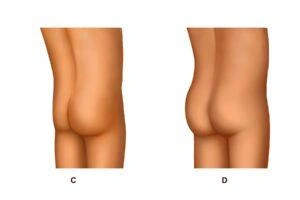Understanding Body Masculinization Surgery
Medically reviewed by Jennifer Richman on June 13, 2025.
What is Body Masculinization Surgery (BMS)?
Body masculinization surgery (BMS) refers to the use of targeted liposuction, skin excision, and/or pectoral implants to help trans men and transmasculine non-binary patients feel more aligned with their bodies. These procedures are sometimes called “FTM body contouring” or “gender-affirming body sculpting.” We recognize that there is no one way to look masculine, and therefore, there exists no one-size-fits-all approach to body masculinization. If you are interested in creating an individualized plan for your surgery or have questions about your specific case, you can request a free consultation with one of our surgeons here.
Body Masculinization Surgery Options
There are three options of procedures that can be combined or performed alone: liposuction, skin excision, and body implants (pectoral). Let’s go through a few of them:
Masculinizing Liposuction
Liposuction can help eliminate stubborn, unwanted fat from areas that have not been reduced by consistent diet and exercise. This procedure is not a weight-loss strategy, but rather something that can be used to help alter the shape of the body. Liposuction can target the following areas:

Abdominoplasty and Skin Excision
These procedures involve removing undesired overhanging skin in any area of the body. For example, when liposuction alone is not sufficient for a patient, an abdominoplasty or “tummy tuck” can help them reduce their body dysphoria by eliminating unwanted skin and tightening abdominal muscles. To excise and tighten overhanging skin and tighten, a scar will be created. You can speak with one of our surgeons in a free consultation to discuss how to conceal the scars and otherwise reduce their visibility through scar care.
Top Surgery
Chest reconstruction top surgery is not a body contouring procedure, but often a part of body masculinization surgery. Depending on the patient’s unique anatomy, a variety of techniques can be used to give the chest as flat an appearance as the patient would like.
Pectoral Implants
Silicone pectoral implants can be inserted to enhance the chest and create a more defined, muscular pectoral appearance. For trans men and non-binary folks that have undergone top surgery, pectoral implants can help patients experience greater feelings of gender euphoria with the contour of their chest.
Mons lift, mons resection, and panniculectomy
While an abdominoplasty targets loose skin and fat in the abdominal area, a mons lift, mons resection, and panniculectomy target the loose skin and fat in the upper groin area, below the abdomen. These procedures can help trans men and transmasculine non-binary patients who have undergone bottom surgery give the penis a more forward, apparent position on the body.
- Mons resection and/or panniculectomy for bottom surgery patients. This surgery involves using liposuction and skin removal of the lower abdominal area to help give the penis a more forward, apparent position on the body. For more information about additional masculinizing bottom surgery procedures, click here.
Is BMS/Body Contouring right for me? Which procedures should I undergo?
For some patients, it is helpful to think about what specific areas they want to target. For example, patients who experience hip dysphoria or dysphoria from having a “pear-shaped” body frame may want to target those zones through liposuction and/or an abdominoplasty. This may include taking fat out and/or tightening skin around the hips, abdomen, buttocks, thighs, under arms, and other zones upon request.
Body Contouring and Waist-to-Hip Ratios
Approaches to body contouring to obtain a conventionally “masculine” body shape often aim to obtain a waist-to-hip ratio (WHR) range that is close to the WHR of those who went through a first, testosterone-dominant puberty. Specifically, the WHR most commonly associated with a masculine figure falls within the 0.85-0.95 range. If you are curious, you can measure your own WHR by dividing your waist measurement by your hip measurement.
Liposuction of the buttocks, hips, and trunk, alongside an abdominoplasty, can help create this effect.
<span class=”yoast-text-mark” style=”font-weight: 400;”>>In addition to gender-affirming body contouring surgery, it’s recommended that transmasculine people who want more muscular upper bodies should focus on upper-body weight training. Concentrating on building muscle in the back, neck, and shoulders can broaden and define the upper body, further enhancing waist-to-chest measurements.
Creating a Conventionally Masculine Waistline
The waistline of people who went through an androgenic puberty is significantly higher than those who went through an estrogenic puberty. This is largely because of bone structure. An estrogenic puberty widens or expands the pelvis, bringing the waistline further down on the body. Below, figure A shows the pelvis of an adult who went through an androgenic (testosterone-dominant) development, whereas figure B shows a widened pelvis resulting from an estrogenic development.

Liposuction is one of the most viable options for lifting the appearance of the waistline. Hormone replacement therapy (HRT), such as testosterone, cannot change the bone structure of the body, and the currently available options to change the pelvis have risks significant enough as to make them untenable. Lifting the waistline through liposuction of the abdomen, hips, and lower back can have a significant positive impact on the fit of male clothing. When done appropriately, contouring will decrease the hourglass silhouette featured in figure B below so that the body looks more like figure A. Thus, liposuction and possibly fat grafting can be powerful tools for androgenizing the body’s frame.
Abdominoplasty and/or lifting the waistline through liposuction of the abdomen, hips, and lower back can have a significant positive impact on the fit of male clothing. When done appropriately, contouring will decrease the hourglass silhouette featured in figure B below so that the body looks more like figure A. Thus, liposuction and possibly fat grafting can be powerful tools for masculinizing the body’s frame.

Body Contouring and Gluteal Forms
Below, you’ll see that the androgenic body form featured in figure C has a concave/flat appearance. Body contouring of the gluteal region would aim to remove the fullness of figure D so that they have an appearance more like figure C. Overall, buttock as well as thigh liposuction can help de-feminize the appearance of the lower body by eliminating or reducing curves so that a more squared-off body shape prevails.
Body Masculinization Surgery Before and After Results
The following before and after photos come from two of Dr. Mosser’s BMS patients.
BMS Candidacy Requirements
The following factors are taken into account when determining an ideal candidate for body masculinization surgery:</span>
- HRT: Though hormone replacement therapy (HRT) is not a requirement for surgery, it can have a positive effect on fat redistribution, changing the gluteal shape, and assisting with building muscle mass. For patients whose transition process involves HRT on regular or full doses, it is recommended to wait until hormones have taken effect for at least a year before undergoing a body contouring procedure. Still, many patients experience difficulty with reducing fat reserves around the hips, legs, buttocks, abdomen, and underarms with HRT, exercise, and diet alone. This is why, even with hormone usage, some find it necessary to undergo a body contouring procedure to feel aligned with the shape of their bodies. While HRT is a requirement for some surgeons, it is not at the GCC.
- <b>BMI: Body Mass Index (BMI) limitations for body contouring procedures have less to do with medical necessity to qualify for surgery and more to do with accomplishing realistic goal</span>s. Generally speaking, patients with BMIs over 32 might have limited or minimal results. If you have specific questions about how you can meet your body contouring goals given your body type, we encourage you to speak with one of our surgeons in a <span style=”font-weight: 400;”>free consultation>.
- Informed consent: The GCC uses the informed consent process to determine surgical eligibility for body contouring. However, patients who would like to gain insurance coverage for their procedure will need to obtain a support letter from a licensed mental health provider.
- Medical clearance: Depending on the procedures you select, you may need to first undergo certain medical examinations. It is important that you be as transparent with your surgeon as possible about your medical history so that we can ensure your safety during and after surgery.
Choosing a Qualified Surgeon
Selecting the right surgeon is crucial for achieving optimal results and ensuring a safe and successful body masculinization surgery. Our surgeons at the GCC (Gender Confirmation Center) are board-certified with extensive experience with gender-affirming surgeries and gender-affirmative care.
When researching potential surgeons, consider the following factors:
- Board Certification: Ensure that the surgeon is board-certified by the American Board of Plastic Surgery or another reputable organization, indicating their extensive training and expertise in plastic and reconstructive surgery.
- Experience with Gender-Affirming Surgeries: Look for surgeons who specialize in gender-affirming procedures, particularly body masculinization surgeries, and have a proven track record of successful outcomes. According to the World Professional Association of Transgender Health (WPATH), surgeons should be knowledgeable about diverse gender identities and expressions, pursue continuing education in the field of gender-affirming surgery, and have an active practice in gender-affirming surgical procedures.
- Hospital Privileges: Choose a surgeon who has operating privileges at accredited hospitals or surgical centers, ensuring access to quality facilities and support staff.
- Before and After Photos: Review the surgeon’s portfolio of before and after photos to assess their aesthetic skills and the quality of their work.
- Patient Reviews: Read reviews and testimonials from past patients to gain insight into the surgeon’s bedside manner, communication skills, and overall patient satisfaction.
- Consultation Experience: Attend a consultation to assess the surgeon’s professionalism, attention to detail, and ability to understand your specific goals and concerns. You can schedule a free virtual or in-person consultation with the GCC here.
Frequently Asked Questions About Body Masculinization
Does insurance cover body masculinization?
Some insurance plans that cover gender-affirming surgery may offer coverage for body masculinization surgery when patients provide the proper support documentation.
If you have insurance coverage and we are a contracted provider, we are unable to offer you an out-of-pocket price for your medically necessary body contouring (liposuction and/or fat grafting procedure). This is due to the service being reimbursed at a drastically reduced amount, limiting our ability to provide this service at a reasonable reimbursable rate.
In the past, GCC billed for multiple units, each representing different areas on the body, and the procedure was reimbursed based on the number of units. However, insurance companies are now reimbursing for only one (1) unit, regardless of the number billed.
Please note that managed Medi-Cal plans, such as San Francisco Health Plan (SFHP), coverage has not changed for Liposuction, ensuring flexibility in Liposuction units.
For information about prices and financing options, we invite you to consult this page.
How long does body masculinization last?
The results of liposuction and skin excision procedures can be permanent. However, significant fluctuations in overall body weight will change and potentially diminish surgical results.
Is there a medical surgery that will result in the most masculine features?
Conventionally masculine body frames tend to have shoulders that are wider than or the same width as the hips. Abdominoplasty and liposuction that targets the hips, buttocks, flanks, abdomen, lower back, and even thighs can help create a more masculine body contour.
Recovery from Gender-Affirming Body Contouring
The recovery process after body masculinization surgery can vary depending on the specific procedures performed and the individual’s healing rate. However, most patients can expect the following:
- Initial Recovery Period: Patients can expect to experience pain, discomfort, swelling, and bruising for at least the first three weeks after surgery. That said, moderate to severe pain should subside around five days post-op. Pain medication will be prescribed to manage any discomfort during this initial phase. At least for the first three days post-op, you will need a support person to help you with household chores.
- Bathing: Patients should wait 24-48 hours after surgery to start showering. The compression garments can be taken off for short periods of time to shower. There may be further showering restrictions if a body masculinization procedure is combined with another procedure, such as chest reconstruction/top surgery. Patients should not take baths or submerge themselves under water for the first three weeks post-op.
- Compression Garments: Depending on the procedure(s) you undergo, you will need to wear specialized compression garments for three weeks to three months after surgery. We will provide you with these garments to help minimize swelling, support the healing process, and shape the new contours created during the surgery.
- Diet: Most surgeons recommend that patients follow a low-sodium diet for the first two weeks after surgery to reduce inflammation.
- Work and Activity Restrictions: Most patients can return to work about two weeks after surgery. However, strenuous physical activities, heavy lifting, and certain movements may be restricted for up to six weeks after surgery.
- Follow-up Appointments: Regular follow-up appointments with the surgeon will be necessary to monitor the healing process, address any concerns, and ensure optimal results.
The Healing Process and Timeline for Body Masculinization Surgery
Mastectomy (Chest Masculinization Surgery):
Initial/Short-Term Recovery: Most patients see a reduction in swelling and discomfort within 3 weeks, with daily activities being able to be resumed in 4-6 weeks.
Long-term Recovery: At ten weeks or more, you will enter the long-term recovery stage, with most visible scaring and swelling greatly reduced by the 3rd month.
Facial Masculinization Surgery (FMS):
Since FMS involves various procedures, including rhinoplasty, jaw contouring, and Brow bone augmentation & hairline repositioning, recovery times may vary*
Initial/Short-Term Recovery: Improvement in swelling and bruising (which is common) is typically seen within 2 to 3 weeks; the resolution and settling of features can take 3 to 6 months.
Long-term Recovery: It can take up to a year or more for the final results of facial bone contouring and rhinoplasty to become fully apparent.
Body Contouring:
Liposuction and fat grafting procedures may be able to be performed on an outpatient basis, but consult with your surgical team first*
Initial/Short-Term Recovery: Depending on the depth of the procedures and removal, it can take 2-4 weeks for initial recovery.
Long-term Recovery: Within 8-10 weeks, you should be able to resume your light/normal daily activities.
Metoidioplasty:
Initial/Short-Term Recovery: A hospital stay of 1 to 3 days is a typical requirement, followed by an initial recovery period of about 2 to 4 weeks. Pain, bruising, and swelling are common, with the ability to return to normal activities occurring after 6 to 8 weeks.
Long-term Recovery: Full recovery and reduction of residual swelling can take up to 8 to 12 weeks, with some residual discomfort subsiding within a few months.
Phalloplasty:
Since this is a multi-stage procedure, recovery timeframes will vary depending on the specific surgical techniques used and the need for additional surgeries*
Initial/Short-Term Recovery: Patients are usually required to stay in the hospital for 5 to 10 days post-surgery. Then the first 4 to 8 weeks are focused on healing, with patients not performing ANY strenuous activities or heavy lifting.
Long-term Recovery: It can take up to 8 to 12 weeks to return to light/normal levels of activity, with full healing taking up to a year or more.
It’s important to follow the surgeon’s post-operative instructions carefully and attend all scheduled follow-up appointments to ensure a smooth and successful recovery. As you plan for your surgery, remember to consider taking the time to request accommodations from your employer, develop a care plan with family and friends, and build a financial cushion to rely on during your recovery period.
The Risks and Benefits of BMS
Like any surgical procedure, body masculinization surgery carries potential risks and complications that you should consider carefully..
- Infection: As with any surgery, there is a risk of developing an infection, which can prolong the recovery process and lead to additional complications.
- Bleeding and Hematoma Formation: Excessive bleeding during or after the procedure can lead to the formation of hematomas, potentially requiring additional treatment.
- Scarring: While efforts are made to minimize scarring, some scarring is inevitable and may be visible, depending on the extent of the procedures performed. Scars can be concealed by carefully following healing protocols and/or through the surgeon’s strategic placement of incisions.
- Implant Complications: In the case of pectoral implants, there is a risk of implant displacement, rupture, or capsular contracture (hardening of the tissue surrounding the implant).
- Asymmetry or Contour Irregularities: Achieving perfect symmetry and contours can be challenging, and some irregularities or unevenness may be present after the surgery.
Despite these potential risks, body masculinization surgery can offer numerous benefits. Especially for individuals seeking to align their physical appearance with their gender identity. Some of the benefits we have heard from our patients include:
- Enhanced Self-Confidence: Achieving a physical appearance that aligns with one’s gender identity can lead to a significant boost in self-confidence and overall well-being.
- Alleviated Gender Dysphoria: By addressing the physical aspects of gender dysphoria, individuals may experience a greater sense of gender congruence and gender euphoria.
- Improved Quality of Life: Many individuals report an improved overall quality of life after undergoing body masculinization surgery, as it can help alleviate the distress and discomfort associated with gender dysphoria.
It is essential to carefully weigh the potential risks and benefits with the guidance of a qualified surgeon. This will help you make an informed decision that aligns with your personal goals and priorities. If you would like to discuss these factors and more, you can meet with one of our board-certified surgeons in a free consultation.
Request a Free Surgical Consultation Today.
All virtual and in-person consultations with our board-certified surgeons are free. Once you fill out this form, our patient care team will reach out and guide you through every step to get to surgery.







